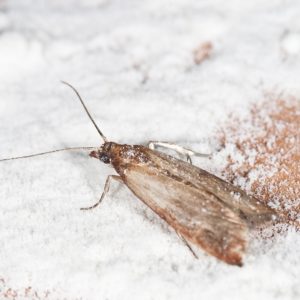What Causes Pantry Moths & What to Do When You Find Them
By: EarthKind
Have you ever noticed weird clumps in an old bag of flour or even a new one you just got from the grocery store? Ever noticed webbing along the corners or edges of food packaging or rice that appears to be moving? If the answer is no, you’ve luckily managed to avoid this unsettling experience. If the answer is yes, you’ve seen pantry moths.
Understanding more about these unpleasant pests can help with removing them from your home, as well as preventing them in the future. Find out what causes pantry moths, where they come from, and the life cycle stages they go through.
What Are They?
The term ‘pantry moth’ usually refers to the Indian meal moth, also commonly referred to as a ‘flour moth’. The name “Indian meal moth” came from an entomologist who observed their larvae infesting cornmeal, which was commonly called “Indian meal” in the 1800’s. The two other names came about due to the location these pests are commonly found inside of a home.
While there are numerous different types of these pests, the Indian meal moth is the most common household pantry pest in the United States. It is different from other types because it is attracted to stored, typically dry foods, unlike the clothes moth which is attracted to clothing and fabric, or other agricultural pest types. Homeowners sometimes notice the infested foods due to webbing on packaging, clumping within flour or they can see the larvae moving around. But typically, they won’t be noticed until the adult stage when they begin flying around.
Where Do Pantry Moths Come From?
These pests can enter your house in numerous different ways. They can make their way in through open doors and windows. They can enter through openings around dryer vents, plumbing lines, or cables that pass through walls. Another common way they get into your home is by stowing away inside of food packaging or contaminated food from a store or warehouse, like pet food for example. Once they’ve made their way into a food item, the problem will likely get bigger.
Pantry moths are on a mission. Their only objective is to reproduce and they infest places with an abundant food supply. This gives them a safe place to lay their eggs, giving their offspring the best chance of survival. They rely on their sense of smell to find a mate and a food source. Since you may not notice them until you see an adult moth flying around your home, it’s possible they have already laid their eggs somewhere inside.
Keep your home pest free with simple, effective solutions. Subscribe and save!
 The Pantry Moth Life Cycle
The Pantry Moth Life Cycle
There are four stages they will go through throughout their lifetime:
- Egg: Moth eggs are extremely small and a whitish grey in color. An adult female can lay approximately 400 eggs at a time, and they can hatch in just 7 days. As mentioned before, they typically lay eggs inside of food packages due to the abundant amount of food readily available.
- Larva: This is the stage that causes damage. Moth larvae are tiny worm-like eating machines. Their color can be affected by the food they are eating, and the frass (waste) and casings they leave behind will contaminate food, making it unusable. The larval stage typically lasts 2-3 months depending on conditions.
- Pupa: While in the pupal stage, they are in cocoons, usually hidden in cracks, corners, or crevices. Sometimes the cocoons are buried underneath food, causing the matted webs and clumps that may be found when cleaning after a moth infestation. They usually take 15-20 days to develop from pupae into adults.
- Adult: Adult moths appear as winged insects that are attracted to light and fly all around. The purpose of flying around is to find a mate so they can reproduce. They do not have working mouthparts and cannot eat, meaning their only objective is to reproduce. However, since the other stages of the moth life cycle are incredibly stealthy, you may not notice an infestation until this stage which can last one to two weeks.
When you add their life cycle stages together, pantry moths typically live around 3-4 months total.
Are They Harmful?
Pantry moths aren’t known for spreading disease, but they can contaminate food in the home kitchen or pantry. This can be unsettling to see and expensive to replace. In food processing facilities, their webbing can cause major damage to machinery.
If you notice these pests inside your home, it’s time to do a thorough check of your pantry items. Unfortunately, any items you see that are contaminated will need to be tossed. You’ll want to check items that were close as well and throw them away if you notice any signs of these creatures.
Placing all dry foods inside airtight containers before storing them in your pantry can help prevent this problem from occurring. It’s also a good idea to do a routine check of the food items in your pantry, even the new, sealed containers you may have just brought home.
Preventing household pests is easier than cleaning up after an infestation. If your home is already infested, then it’s important to be proactive with the issue and work quickly to remove the problem. Learn more about preventing and getting rid of pantry moths naturally here and consider using Stay Away® Moths, a fast-acting, botanical repellent that you place in the problem area to help.







 The Pantry Moth Life Cycle
The Pantry Moth Life Cycle

 day
day
If you live in a seasonal area, the best way to kill them is at winter time is to shut off the furnace and let it freeze. This kills them all no matter where they are.
Hi there,
Thanks for sharing your DIY advice to get rid of moths! Turning off the furnace might not work for everyone depending on their living situation and climate, but you’re right that cold temperatures are one way to get rid of moths without harmful chemicals. Removing dry goods from their original packaging and placing them in the freezer for one week will take care of any moths or larva that may have been present and prevent pantry infestations.
Thanks for reading!
How can you tell where they are coming from?
Hi Mary,
Finding the source of a moth infestation can be tricky. Infestations usually result from bringing something into your home that already has moths (or moth larvae). To identify the contaminated item, you will need to examine each item in the pantry or cupboard. Use this opportunity to transfer items from the original packaging to an air tight storage bag or container if possible. While you are doing this, make sure to clean shelves, baseboards, flooring and walls (pay special attention to corners and hard to reach areas) to get rid of any moth eggs that may be waiting to hatch.
Thanks for reading!
Hi, I work in a health food store that carries bulk grain & nuts. We have been dealing with these moths for some time. A pest control company comes in & puts out the sticky traps & it helps some but we still are throwing food away.
My question: We have several non-working refrigerators. Would storing some of the food items in those at least help reduce the moths? Could they get out or would it at least trap them in a smaller area if in the foods?
Thanks
Hello Michelle,
Thank you for reaching out!
The best way to prevent moths is by storing food in sealed containers, which can be challenging when dealing with larger quantities and environments. Storing goods in non-working refrigerators may help contain the moths. Moths cannot survive extreme temperatures, so if possible, try placing items in a freezer for one week to kill any existing larvae, preventing further infestations.
As you mentioned, trapping can help to catch some of the moths, but it doesn’t exactly solve the problem. We would recommend using a repellent like Stay Away Moths to prevent recurring infestations. Start by disinfecting the area to remove any existing larva. After you have cleaned up, pouch up the warehouse with Stay Away Moths repellent pouches. This will keep the moths away releasing a proven blend of essential oils that repel moths for up to three months. The best part is that the ingredients will not contaminate the food, unlike other products such as mothballs.
Please contact our Customer Care Team ([email protected]) to discuss more ways we can help your business and process your order. We have plenty of retailers that use or products to repel pests and protect their investments.
This article has other great information that you will find helpful: How to Get Rid of Moths from Your Home Safely and Permanently
Thank you for reading!
Hi,
When the eggs hatch can the larva move onto the next stage without ever finding food? I had a bad infestation of moths and cleared out the whole pantry, cleaned it with bleach, caulked all the cracks in my cupboards. For a few weeks there were still a lot of moths appearing from behind the empty cupboard, presumably hatching from whatever cocoons were left in nooks and crannies I couldn’t find. I killed them as soon as I saw them and thought things were finally almost over – it’s been a week now since I’ve seen any moths. But today in the still-empty cupboard I found a brand new COCCOON (out in the open, in an obvious spot I’ve cleaned a zillion times – there is no way it’s an old one and I just missed it). I’m surprised because there is no food anywhere the larva could have reached. My pantry has been empty for several weeks, with all food still stored in the fridge/freezer. So if more new larva hatch and there is no food, will they be able to continue the life cycle instead of starving?
Hi Haley!
You are in the right path! Do not give up. It can take quite a while to get rid of pest infestation. Continue doing what you are doing. When the moth lays the egg, they do it in a dark place and leave food behind with them. An adult (imago) most have been around or eggs remained hidden. So cleaning and getting rid of the food (like you are doing) will starve them to death. It does takes time, but it seems that you are close.
Give a try to Stay Away Moth. It works by using moth’s highly developed sense of smell against them. Moths use their sense of smell to communicate, to detect food and find mates. Stay Away® Moths will block the scents they are searching for and cause them to avoid the treated area. Take a look at this video Learn How To Control Moths with EarthKind to see how it can help you repel the moths and keep them away from your home
Thank you for reading!